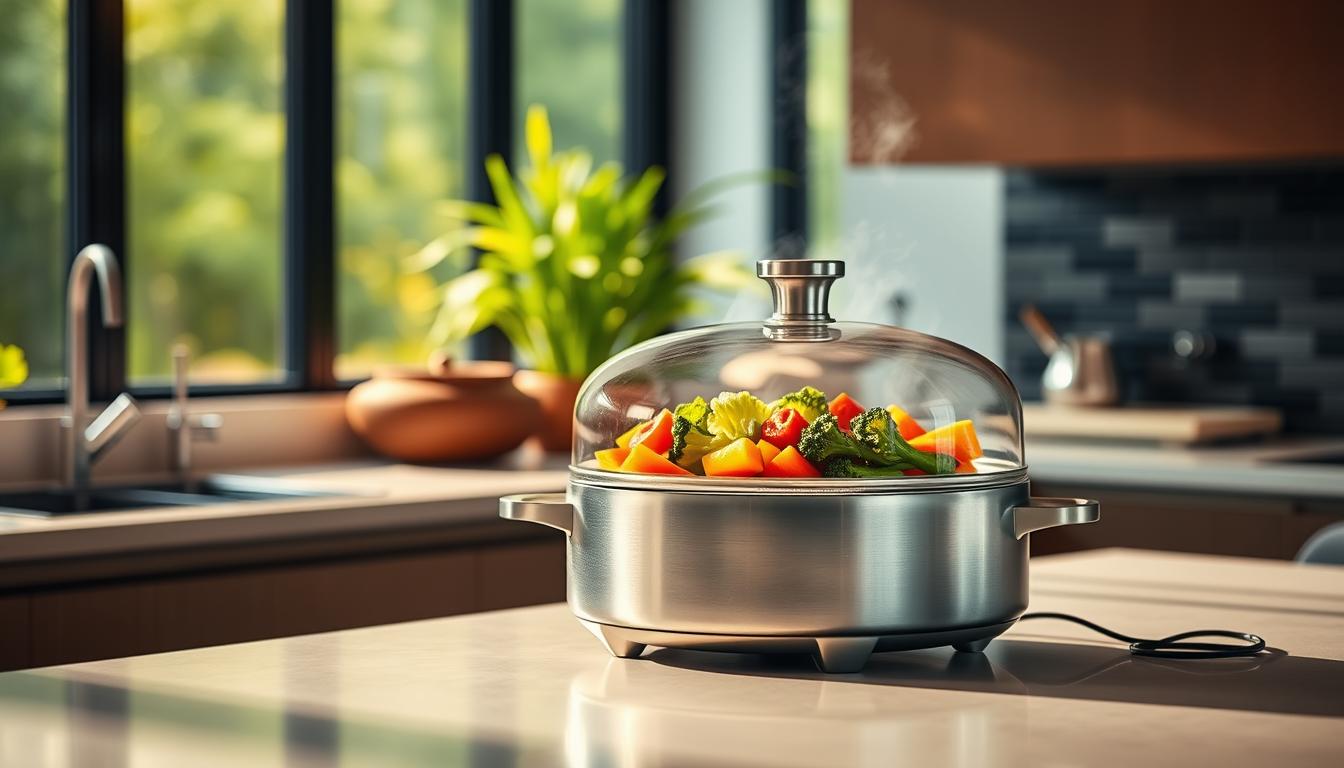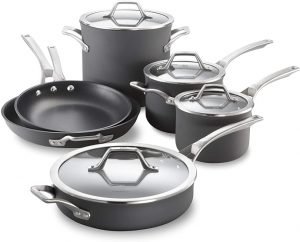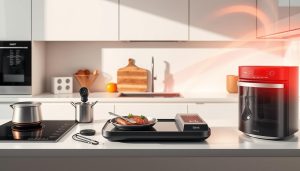Did you know steam transfers heat 12 times faster than hot air? This simple fact explains why chefs worldwide rely on vapor to create dishes bursting with flavor and nutrients. While boiling or baking often leads to uneven results, steam’s unique properties unlock precision that transforms everyday meals.
At 212°F, water becomes an invisible powerhouse. The vapor penetrates ingredients evenly, preserving textures and vitamins that dry heat destroys. Professional kitchens have used this method for centuries, but modern tools now bring that same accuracy to home cooks.
You’ll find this approach eliminates guesswork. Whether preparing vegetables or proteins, the gentle process maintains moisture while enhancing natural tastes. Advanced appliances build on timeless principles, letting you achieve consistent outcomes without specialized skills.
Key Takeaways
- Steam transfers heat 12x more efficiently than air
- Operates at precise 212°F for consistent results
- Preserves up to 50% more nutrients than boiling
- Preferred by chefs for delicate proteins and vegetables
- Modern devices simplify temperature control
- Prevents flavor loss from high-heat methods
Unveiling the Science of Steam Cooking
Have you ever wondered why steamed vegetables stay vibrant while roasted ones lose color? The answer lies in vapor’s ability to transfer energy without stripping away what makes ingredients shine. Unlike dry methods, this approach uses physics to lock in texture and taste.

How Vapor Transforms Food
When water hits 212°F, it becomes an invisible force. This vapor carries 3,500 times more energy than air, wrapping ingredients in consistent warmth. Proteins stay supple because the moisture prevents fibers from tightening too quickly.
Dense vapor fills every corner of your cooking space. No more unevenly cooked broccoli florets or dry chicken breasts. You get predictable results because the system eliminates hot spots that plague ovens and pans.
The Power of Condensation
Here’s where magic happens: when vapor touches cooler food surfaces, it releases stored energy. This “latent heat” penetrates deeper than dry methods could. Vegetables cook through without becoming mushy, retaining up to 50% more nutrients than boiling.
The process also creates a protective shield. Moisture surrounds your ingredients, stopping natural juices from escaping. Flavors intensify instead of evaporating, giving dishes complexity without added oils or seasonings.
Modern appliances harness these principles precisely. You control temperature and timing to achieve textures that rival professional kitchens. It’s not just cooking—it’s engineering meals through vapor’s unique properties.
Fundamentals and Health Benefits of Steaming
What if your meals could deliver more nutrients while tasting better? This cooking approach outperforms boiling and roasting by protecting what makes ingredients valuable. The secret lies in gentle heat that maintains integrity from plate to palate.

Retaining Vitamins and Minerals
Water-soluble nutrients like vitamin C and B-complex often disappear in boiling water. Steaming keeps 90% of these compounds intact by avoiding direct contact with liquid. Leafy greens retain 50% more folate compared to methods that submerge them.
Minerals like potassium and magnesium stay locked in foods through vapor’s delicate touch. A study comparing broccoli preparation methods found steamed samples preserved 85% of their iron content versus 60% in boiled versions.
| Cooking Method | Vitamin C Retention | Mineral Retention | Color Preservation |
|---|---|---|---|
| Steaming | 90% | 85% | Vibrant |
| Boiling | 45% | 60% | Faded |
| Roasting | 70% | 75% | Charred |
Preserving Natural Flavors and Colors
Vapor acts as an invisible shield, preventing flavor molecules from escaping. Carrots develop sweeter notes as their sugars concentrate instead of dissolving. Bright orange hues signal preserved beta-carotene – a key antioxidant.
You’ll notice meats stay juicier without added fats. Salmon cooked this way retains 30% more omega-3s than pan-seared versions. Even grains like quinoa gain nuttier profiles when prepared with controlled moisture.
Diverse Methods to Steam Your Food
Ever explored how professional kitchens achieve perfect textures across diverse dishes? Multiple methods let you harness vapor’s power using everyday tools or advanced appliances. Each approach adapts to your kitchen setup while delivering nutrient-rich results.

Stovetop and Microwave Techniques
Your stovetop becomes a steam powerhouse with a metal basket or improvised setup. Adjust heat settings to control vapor intensity—ideal for delicate fish or leafy greens. A colander placed over simmering water works when specialized tools aren’t available.
Microwave techniques offer speed without sacrificing quality. Use vented containers to trap moisture around vegetables or grains. This method preserves crispness in snap peas or asparagus in under three minutes.
Oven and Combi Oven Approaches
Transform conventional ovens by placing water-filled trays beneath ingredients. This creates ambient moisture for even cooking of root vegetables or whole poultry. Monitor water levels to maintain consistent steam production.
Combi ovens merge dry heat with precision vapor injection. Program settings for dishes requiring caramelized surfaces and tender interiors—like crusty bread or braised meats. Built-in sensors adjust humidity automatically for foolproof execution.
| Method | Setup Time | Control Level | Best For | Equipment Needed |
|---|---|---|---|---|
| Stovetop | 2 minutes | High | Vegetables, fish | Pot + basket |
| Microwave | 1 minute | Medium | Quick sides | Vented container |
| Oven | 5 minutes | Medium | Large cuts | Baking tray |
| Combi Oven | Instant | Precise | Multi-course meals | Steam oven |
Essential Tools and Appliances for Steam Cooking
Upgrading your kitchen setup unlocks vapor’s full potential. Modern steam ovens and specialized accessories turn complex techniques into effortless routines. You’ll discover how the right equipment elevates everyday meals through precise moisture control.

Choosing a Steam Oven or Combi Oven
Capacity matters most when selecting appliances. Built-in models like AEG’s Compact Steam Pro fit standard cabinet cavities, while countertop units offer portability. Check if your home has plumbing access—some premium brands connect directly to water lines.
Combi ovens merge convection heating with vapor injection. Porter & Charles models let you adjust humidity levels and fan speeds simultaneously. This dual-action system crisps salmon skin while keeping flesh moist—something basic ovens can’t achieve.
Additional Kitchen Accessories for Effective Steaming
Perforated pans ensure even heat distribution in your steam oven cavity. Bamboo baskets work wonders for dumplings or greens on the stovetop. SMEG’s accessory kits include solid containers for grains and racks for multi-layer cooking.
- Heat-resistant glassware prevents warping during high-temperature cycles
- Stainless steel trays simplify cleanup after oily proteins
- Digital probes monitor internal food temperatures in real time
Your pot collection gains new purpose with silicone steamers. These collapsible inserts adapt to various saucepan sizes, perfect for quick vegetable sides. Pair them with tight-fitting lids to maximize vapor retention.
Mastering Techniques for Consistent Results
Want restaurant-quality dishes every time? Perfecting vapor-based preparation eliminates variables that cause uneven cooking. Modern tools and tested methods turn your kitchen into a precision workspace.
Step-by-Step How-To for Stovetop Steaming
Start with a heavy-bottomed pot and stainless steel basket. Fill with water until it sits ½ inch below the rack – this prevents boiling liquid from touching ingredients. Bring to a simmer before adding food to maintain steady vapor flow.

- Use tight-fitting lids to trap circulating air
- Check water levels every 8 minutes
- Layer delicate items above dense vegetables
Utilizing Digital Sensors and Convection in Modern Ovens
Advanced units like Wolf’s Steam Oven combine multiple technologies. Built-in hygrometers measure humidity while fans distribute moist air evenly. This dual-action system reduces cooking times by 25% compared to traditional methods.
| Feature | Traditional Oven | Convection Steam Oven |
|---|---|---|
| Heat Distribution | Uneven | 360° circulation |
| Doneness Control | Manual checks | Auto-adjusting sensors |
| Energy Use | High | Optimized |
Programmable settings handle complex tasks. You can sear fish skins while keeping interiors tender – something impossible with basic appliances. The technology helps food retain natural juices better than any other method.
Innovative Cooking Methods: From Sous Vide to Advanced Steam Techniques
What separates amateur dishes from Michelin-starred creations? Precision control over temperature and moisture now comes home through hybrid techniques. Modern kitchens blend sous vide’s accuracy with vapor’s efficiency, creating textures that defy conventional expectations.
Integrating Sous Vide with Steam Cooking
Vacuum-sealing removes insulating air pockets, letting vapor penetrate ingredients uniformly. This combination ensures salmon reaches 125°F internally while staying moist externally. Chefs use this method for proteins requiring exact doneness without dryness.
Customizing Heat and Moisture Settings
Combi ovens let you adjust humidity separately from heat. Start with 90% moisture to lock in juices, then reduce to 30% for crispy surfaces. This flexibility transforms tough cuts into tender masterpieces while preserving natural flavors.
| Feature | Traditional Methods | Advanced Techniques |
|---|---|---|
| Setup Time | 10+ minutes | Instant programming |
| Control | Manual adjustments | Sensor-driven automation |
| Results | Variable textures | Restaurant-grade consistency |
Modern oven cavity designs circulate vapor intelligently. You can steam vegetables below while roasting meats above – all in one cycle. Explore how these systems elevate food preparation science through calculated airflows.
Your kitchen becomes a lab where moisture and temperature experiments yield edible art. Adjust settings mid-cook to caramelize surfaces without overcooking centers. The future of flavor lives where technology meets tradition.
Conclusion
Mastering vapor-based preparation elevates everyday meals into nutrient-rich experiences. This method outperforms boiling and roasting by preserving up to 90% of vitamins in delicate greens and proteins. Your kitchen becomes a precision workspace, whether using bamboo baskets or advanced oven systems.
Modern appliances simplify the process dramatically. Built-in recipes and digital controls remove guesswork, letting you focus on flavor combinations. You’ll notice brighter colors and richer tastes in dishes cooked with consistent moisture levels.
From stovetop setups to combi ovens, options exist for every home cook. These tools lock in natural juices better than dry-heat methods, transforming basic ingredients into vibrant plates. The result? Healthier food with textures that rival professional kitchens.
Embrace this approach to unlock food’s full potential. With minimal effort, you’ll create dishes that nourish body and palate equally – a true upgrade for any culinary routine.



